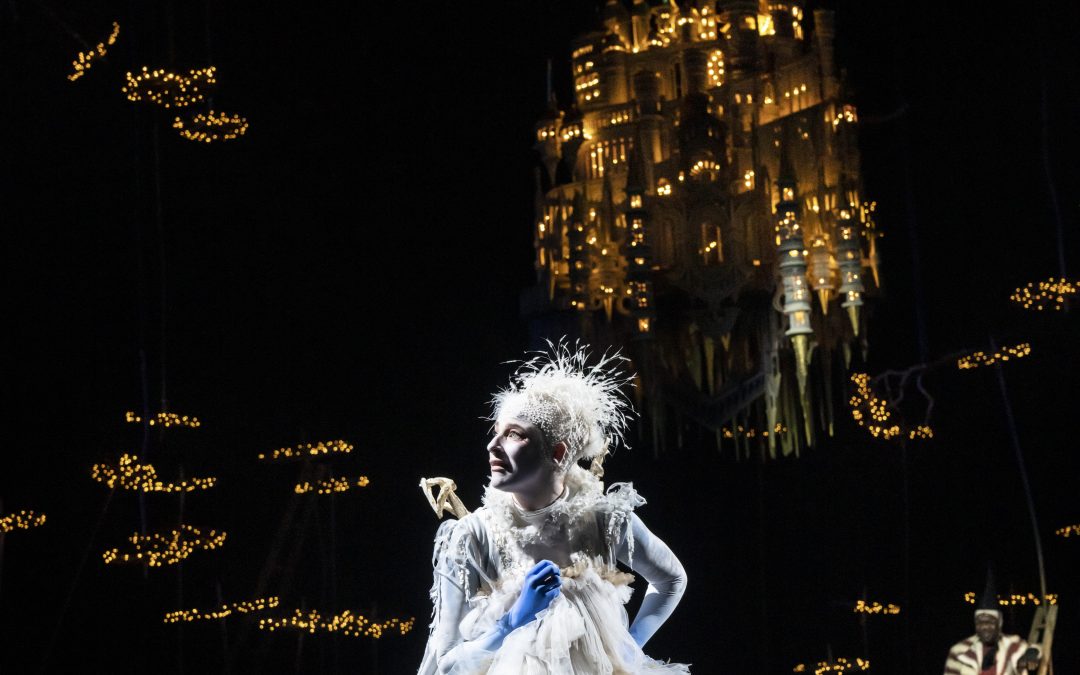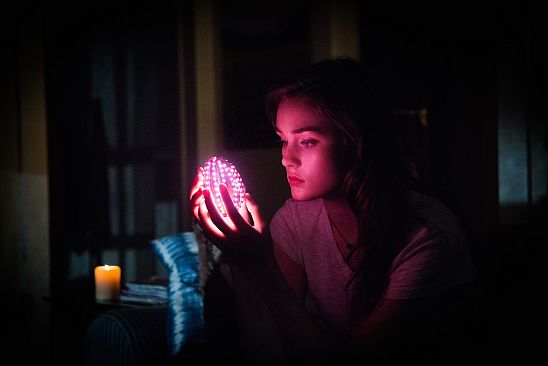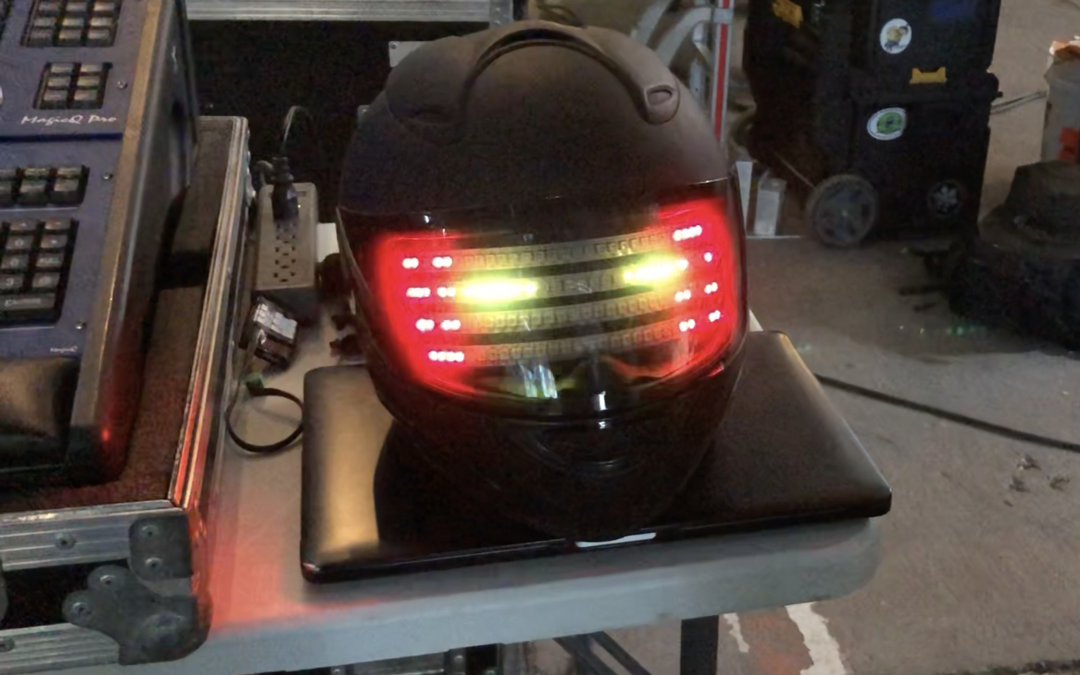
by Aimee Wilson | Oct 31, 2022
For those on the American side of the Atlantic, the National Theatre in London, UK is THE most prestigious theatrical venue. Founded by the legendary Sir Lawrence Olivier in 1963, it comprises several venues: the Olivier Theatre, the Lyttleton Theatre, and the smallest venue, the Dorfman Theatre. They are also home to Lighting Technician Alex Varlow, who happens to have a fondness for wireless dimming and specifically RC4 Wireless. “I first started working with RC4 in 2014, when I began as a freelancer at the National Theatre,” Varlow explains. “Since then, I have worked on countless shows and can only think of a handful which didn’t use RC4. The flexibility, size and reliability make it a powerful tool to be rolled out on almost every show I have worked on here.”
Varlow gave his RC4 Wireless gear a workout on two recent shows: ‘Hex’, based on Sleeping Beauty and a modern version of ‘Much Ado About Nothing’. Varlow notes, “‘Hex’ was our post-COVID Christmas musical in the Olivier Theatre. My role as Floor Electrician was to design, build and run the set, costume and hand-held practical lighting elements. ‘Much Ado About Nothing’ has recently opened in the Lyttelton Theatre. For this production, I was Assistant Lighting Supervisor. Similarly to ‘Hex’, the set had a large amount of practical lighting, which I designed and built with our brilliant inhouse props team. ”
First, the wireless aspects of ‘Hex’. “Being based around Sleeping Beauty, we knew early in the design process that there was going to be a castle,” Varlow notes. “As the show and design concept grew, we found out that the castle was going to be a flown element, housing a performer that would both track up and down stage and rotate 360 degrees. This meant we couldn’t safely get power or data cables run to it; the castle would have to be wireless. We also had a very strict weight limit, so multiple drivers and excessive cabling was not an option.”
Paul Anderson, the Lighting Designer for ‘Hex’, had another requirement as well: the castle had to be able to change color; Varlow had a solution: the RC4Magic S3 DMXpix Dual Pixel String Driver. “We chose pixel tape to give us added control but being a large set piece, it required over ten metres of product,” reports Varlow. There was only one slight problem. “This would quickly eat up addresses on the Olivier’s dedicated wireless universe.”
As Varlow and many others in the lighting world have discovered, RC4 equipment is not only reliable, but versatile. Varlow continues: “We used RC4s powerful keyframe tool to allow us to control the ten metres of tape in one universe. This gave us the ability to add texture and other interesting color effects to the castle without requiring multiple universes of data.” As for the rest of the production, “The ‘Hex’ castle featured twenty-five channels of fairy lights, Gantom spots and other LED tape hidden inside, all receiving data via an RC4Magic DMXio and functioning without a hitch; in total, we had another fifteen DIM2s controlling various lanterns, costume lighting and smoke effects, running multiple universes on separate IDs simultaneously,” he notes.
When technical issues came up during ‘Hex’, Varlow turned to RC4 customer support. He continues: “We were using a new string of pixel tape which was controlled by a protocol not yet implemented into RC4. James [James D. Smith, CEO and chief product developer] was eager to get his hands on a segment, so we FedExed a segment of the tape to him across the pond. Within a few days, James had mapped out the framework for a TM1814 protocol and sent us a firmware update allowing us to light the ‘Hex’ castle. James’ communication and commitment to solving any issues are second to none. No matter how time consuming or complex, I’ve not managed to stump him just yet.”
While Varlow had to deal with the castle in ‘Hex’, he had a different issue in the modern version of ‘Much Ado About Nothing’. He explains, “Our biggest challenge on Much Ado, from a practical standpoint, was a pair of Art Deco elevator floor indicators, present in the fictional hotel the show takes place within. In early meetings, our Lighting Designer, Lucy Carter, asked for each segment of a floor number light box to illuminate, indicating which floor the elevator was on. She also requested a motorized arrow, which followed the lift’s journey through the numbered floors. The prop was quite small in size and attached to a ceiling inside a revolve. This meant it would not be possible to get data, decoders and cabling to these practicals.”
Once again, Varlow turned to RC4 Wireless products for a solution. “We chose to use a RC4 DMXpix to control pixel tape for the lit floor numbers. Using the keystone tool again, I was able to group the pixels together to make each floor number an individual four-channel RGBW lightbox. To control the arrow, we used a DIM2 running in servo controller mode. This allowed our programmer to accurately select a floor controlling the 180-degree movement as an intensity control,” Varlow explains.
The RC4 Wireless DMXpix and DMXio aren’t the only wireless products from the firm at the National Theatre. Varlow notes, ”We have over seventy RC4 products here at the National, and we are always looking to grow our stock and test their new products. James and his team have offered outstanding support, helping us with any issues we run into; they have the outside-the-box thinking vital for creating products that we find so useful.”
“Flexibility is key to RC4’s success in a theatrical environment,” Varlow states. “Being able to be powered over a wide range of voltages makes them adaptable to many low voltage electrical systems. They are compact and so easily hidden in smaller props, such as lanterns and costumes. Their many different curves and control modes give us the chance to create some really special effects. We’ve hidden IO receivers in large LED walls, installed DIM4s in delicate LED-filled costumes and used DIM2s set as a relay to fire smoke effects. I’m sure we haven’t found all their useful applications… yet,” he concludes.
RC4 Wireless is pleased to support the National Theatre through our UK Partner, Lamp and Pencil. They can be reached at http://lampandpencil.com/contact/.
Hex
A new musical based on Sleeping Beauty : book by Tanya Ronder, music by Jim Fortune and lyrics by Rufus Norris
Director : Rufus Norris
Set and Costume Designer : Katrina Lindsay
Choreographer : Jade Hackett
Music Supervision & Vocal Arrangements : Marc Tritschler
Orchestrations : Simon Hale
Music Director : Tarek Merchant
Lighting Designer : Paul Anderson
Sound Designer : Simon Baker
Consultant Choreographer : Bill Deamer
Associate Choreographer : Bradley Charles
Associate Music Director : Cat Beveridge
Staff Director : Seimi Campbell
Ensemble : Christopher Akrill
Bruiser Thorn : Delroy Atkinson
Ensemble : Esme Bacalla-Hayes
Queenie : Tamsin Carroll
Ensemble : Madeline Charlemagne
Ensemble : Ebony Clarke
Fairy : Rosalie Craig
Ensemble : Sonya Cullingford
Ensemble : Hanna Dimtsu
Ensemble : Tamsin Dowsett
Bert : Michael Elcock
Ensemble : Joe Foster
Ensemble : Ben Goffe
Prince : Eleanor Kane
Queen Regina : Daisy Maywood
Ensemble : Kody Mortimer
Ensemble : Joseph Prouse
Rose : Kat Ronney
King/Prince : Shaq Taylor
Smith : Sargon Yelda

by Aimee Wilson | Sep 6, 2022
“I’ve built my reputation on being the wireless guy since I don’t run any dmx from my cart to my dimmer console, so I’ve made a niche for myself,” states Wilmington, NC-based lighting console programmer Tommy Sullivan Jr. Sullivan’s credits include the SpongeBob Squarepants movie, Swamp Thing; Homeland; and Steven King’s Under the Dome, just to name a few. Some of his success is due to his equipment. “Every single DMX controlled light that we carry on our cart has a RC4 Wireless 900MHz miniature data receiver that we keep on it,” he confides.
Sullivan is also an RC4 Wireless power user. “I have quite the collection of RC4 products; Jim has told me I’m up there with Disney when it comes to the amount of RC4 gear I own,” Sullivan admits. In fact, his collection includes the original RC4 line, RC4Magic, the 900 series and LumenDim devices. Sullivan notes, “I love the RC4 stuff, it’s never let me down”.
Sullivan began working with RC4 equipment in 2014 while he was on the CBS TV drama Under the Dome. Sullivan explains, “I was approached about making an egg that would light up. We explored different options that actors would carry around, and then on cue, it would glow and change colors.” His initial ideas involved wired solutions. “Originally, we were looking at making something that had wires and would be tethered; it would hide a battery pack on the actor. I started doing research online, and stumbled across RC4, and realized that they were also in North Carolina. I thought, ‘this is perfect,’ he says. Sullivan then pulled the metaphorical trigger that would transform his work life. “I gave Jim a call, and got 2.4GHz 2-channel wireless dimmers. I took it, mounted the battery pack inside the egg and it worked perfectly.”
From there, Sullivan moved from the RC4Magic 2.4GHz band to the RC4Magic-900MHz line of products. Sullivan explains, “The 900MHz series of products work better for me because it’s a less congested bandwidth, there are fewer people on it and the range is much better than 2.4. It penetrates stuff better; up here, we have to contend with humidity and rain and all sorts of things that 2.4 doesn’t do well with. The 900 dimmer checks off all the boxes for us and it’s been very reliable.”
One of the challenges that people in all sectors of entertainment have to deal with are buildings and cement; Sullivan has also faced that circumstance. “When I was working on Under the Dome, we shot a lot in an old cement factory that was made completely out of cement. There have been lots of big movies—like Teenage Mutant Ninja Turtles—that shot there going back to the 80s,” Sullivan notes. That’s where he used the RC4Magic-900MHz dimmers. “They worked perfectly,” he reports.
The performance of RC4 gear—especially the 900MHz line—has astonished some of Sullivan’s co-workers. He notes: “I’ve had people come in from out of town on our crew, take a light out in the distance, and say ‘there’s no way you’re going to get signal out to this.’ I push a button; it immediately comes on and they say ‘oh my God.’ “That leads to another happy circumstance. “The next week they’re calling Jim and Aimee to order theirs. Every time I show someone that does what I do, they are instantly turned onto it and end up making a purchase themselves,” Sullivan says with a smile.
The film community in the Wilmington area is a tight-knit one, and Sullivan works hand in hand with his fellow electricians. He has found that the RC4 LumenDim products, which work with Lumen Radio CMRX transmitters, are the perfect solution for many of his props. He explains, “For props, I’ve found it helpful to use the push to pair feature of the LumenDIm dimmers. If a buddy of mine on another show needs to borrow a lantern, I can just give it to him. All he has to do is push it and pair it to his transmitter. We have three shows that are in production in town, and we’re a tight-knit film community, so we share things. Having a push to pair has made that easier.”
RC4 Wireless dimmers aren’t only used for lighting; they’re also great for props. Sullivan has used them for countless lanterns and flashlights, as well as for products that are unique crossovers. He picks up the story: “On Under the Dome, we had a flashlight that the bulb was supposed to explode; then it was supposed to drop on the floor and start vibrating. It was supposed to be possessed.” Creating a possessed flashlight is, as one would imagine, a challenge. “Back then, I was still using the 2.4 system, and I did have some challenges with that, since they wanted it in a Maglite, which was all metal. I had to drill a hole into it to bring the antenna out, and I had to custom-make the battery pack go inside of it. With normal operation, the guys walk around with a flashlight and I was running it at 50%. When it was supposed to blow up, I cranked it up, and the bulb actually blew up,” Sullivan reports.
The story then takes an unexpected turn once the flashlight hits the ground. “Here’s the funny part– I took apart a small personal massager and mounted the motor inside so when the guy dropped it on the concrete, it would start vibrating on the ground. After that, via effects, they made it even more crazy. For what we needed to accomplish on set with the actors, it was perfect,” he reports.
The unexpected surprises continued with the flashlight. Sullivan continues: “Our accountants on the show eventually ended up with the receipt for the vibrator, our Best Boy who does all of the purchasing, got called into the office for it.” It wasn’t the first time that management questioned an unconventional purchase. “The glowing egg that we created, we had to put it underwater, and it comes floating up to the surface. We found the best way to protect it underwater was to use a condom. So, we put the egg in a condom, tightened it up, and sunk it to the bottom. The accountant called him into office for that as well. He explained it and it all worked out, but they had quite a few laughs,” confides Sullivan.
Early on, Sullivan had to call RC4 customer support. “They have hands down the best customer service and technical support of anyone in the market,” Sullivan says. Some of those calls end up going to James D. Smith, RC4’s president and chief product developer. Sullivan adds, “There are not many companies you can call and talk to the developer directly. We’ve spitballed ideas for product improvement, and different ways of doing things and it’s been helpful to have that.”
In the end, Sullivan notes, “I’ve encountered some gaffers—they’re the head of the lighting department—that’s who I work under who say ‘I don’t like wireless, it doesn’t work’.” He has a simple response: “I say you’ve been using the wrong stuff. I’ve had RC4 Wireless equipment work outside for over half a mile away, and still be instantaneous and still do effects that require fast data transmission. It just works flawlessly.”

by Aimee Wilson | Jul 12, 2022
“I became aware of RC4 wireless back in 2015,” states Sean McClellan, a feature film and television gaffer and best boy electric based in Albuquerque. “I was working as a core electrician back on a show called Independence Day: Resurgence, and there were many alien blaster prop guns that had integrated [RC4 Wireless] DMX4dims. That’s where I began to learn about them. Our lighting equipment package outside of the props world encompassed LEDs and included custom-built miniature LED pads and sticks; they were just ribbon-based LED products of various sizes that we would control with RC4 DMX4dims. The RC4 equipment was there, I saw it and thought ‘what is this really cool piece of technology.’ That’s where I got my start learning about the RC4 ecosystem,” he notes.
From there, McClellan began to delve into the world of RC4 Wireless products. “I started to learn about it and when there was a lull between lighting setups, I would sit there on my phone and I would scroll through the user manuals from the website,” McClellan notes. “I would familiarize myself with the product line, how to configure them, how to troubleshoot, and learned what all the blinking lights meant. I really educated myself on the system.” His first RC4 Wireless purchase was the ever-popular DMX4dim. “After I learned that system, I went on to gaff a couple of smaller projects, and I purchased my first set of DMX4dims with the transmitter, the DMXio, and from there, I built my own custom LED pads and sticks. From there on out, my inventory expanded, and I started dipping into LumenDim devices. From there, I primarily stayed in LumenDim.” McClellan has a variety of RC4 Wireless LumenDim devices, including the LumenDimPix and LumenDim micros. “In our workflow, with my gaffer, Jay Kemp, we keep the DMX4dims as a backup system,” adds McClellan.
One of McClellan’s favorite features of the LumenDim products appeared in July of ‘21. McClellan explains: “The latest firmware that just came out-the motion picture profiles, that’s my go-to now because it mimics popular CCT/RGBW modes found in professional lighting products, such as Arri, KinoFlo, and so on. To me, that’s pretty unique. My gaffer and I have newly designed LED pad and stick fixtures that were built to maximize these new profiles, so being able to use that with our programmer and have a seamless profile that works across the board that you can color match more easily, that’s probably my number one go-to feature.” James David Smith, CEO and Chief Product Designer at RC4 Wireless notes, “Last year, I created two new color-control profiles that I based on existing fixtures made by Arri, Kino Flo, and Astera. Since everyone in motion picture work uses those fixtures all the time, it made it much easier for them to use our devices.”
Since McClellan is in New Mexico, he works on plenty of period westerns. “We typically use a lot of the LumenDimM2micro and M4micro units for lantern effects. We’re always modifying handheld lanterns to work wirelessly on batteries. People think it’s just a lantern, but so much goes into it to make it reliable. Not only for the battery, but also being reliable if it gets dropped.” In the winter of ’21-‘22, McClellan was on the film The Pale Blue Eye that used 12 lanterns with RC4 Wireless LumenDimM4micros with external antennas for added signal strength. “Each character had a different style lantern and we had to be prepared with backups in case someone slipped and fell down.” We had three backups for each style of lantern all set, teched-out with the programmer, Kevin Hogan, in case the lantern got dropped and didn’t work,” recalls McClellan. The lanterns—as well as the RC4 equipment—worked perfectly.
RC4 Wireless gear is also there when it’s time to do pixel effects. “Back in 2019, we did a Netflix tv show called Daybreak, and the director wanted to mimic a Daft Punk-style motorcycle helmet. I worked with the rigging gaffer, Theo Bott, and the fixtures foreman, Joshua Phillips, and we used the LumenDimPix pixel drivers. We made a Daft Punk-style helmet for that which looked really cool on camera. Our programmer, Patrick Toohey, did some really cool pixel mapped effects on it,” McClellan states.
Recently, McClellan worked on a film that IMDB calls Wile E. Coyote. He explains, “We primarily used LumenDim4s, LumenDimM4s and M6s to control our LED light pads and litemats. I also worked with the fixtures foreman, Todd Roberts, on that job; they had to build a proxy bomb and wanted to simulate the fuse igniting. We took a couple of LumenDimM4 micros, and stuffed them down in there with some 5 channel LED ribbon to emulate the flicker from a fuse. That’s one of the things I love about the RC4 equipment is the versatility; you can take a device, you can change modes and do a Flickr effect, you can use straight DMX control or you can use RC4 Colormatch™. The versatility in each device is pretty astounding actually; it enables end-users to tailor the device to their work flow and get the desired end results rather quickly.”
For people who haven’t used RC4 equipment, McClellan says, “If someone is working in special effects and they need to control a servo motor or a telephone, they should look at RC4, because chances are they’re going to have some sort of feature that will suit your needs.”

by boss | May 23, 2019
Everyone’s wireless dimming and DMX journey is different. Kat Seaton, Lighting and Projection Supervisor at The Arizona Theatre Company tells her story:
I was working as an Electrician at Scottsdale Community College in 2013 when we had a production that needed wireless dimming; we went with RC4 Wireless. When we got the first products in the theatre, the directors were so excited they wanted to use it on every show. It’s a portable dimmer you can place in the middle of the stage. At the time, we purchased a DMXio transceiver and three DMX2dim wireless dimmers.
RC4 Series 2 products—which are oldies but goodies have been a big part of my next job at The Arizona Theatre Company. I work with a lot of young technicians, that are unfamiliar with these dimmers, and all that they can do. Often believing that if it is older technology that is not working, it is broken rather than learning about it. I work in theater, so I don’t have the budget of someone like Katy Perry or Pink so can’t get something brand new. We have to find ways to make things work, which is why I’m still using RC4 Series 2 products for the past 5 years.
Typically in my world, when there are problems with these dimmers, it’s operator error. When unexpected problems happen, people shouldn’t be afraid to call RC4’s customer service. When I’ve called, it’s been a fantastic experience. At one point when I called, I ended up talking to Jim [James D. Smith] which was kind of mind blowing. You don’t expect to talk to the developer when you call tech support. They are literally the people that have designed it and built it.
Our company performs in two different venues—The Temple of Music and Art and the Herberger Theater Center—and we do every production twice. We do it in Tucson first at the Temple of Music and Art, and then in Phoenix at the Herberger Theater Center. While the production is going on in Phoenix, we begin work on the upcoming production in Tucson. Consequently, we have double of almost everything. When we have a show that needs wireless, it’s typically for moving scenery pieces and we’re trying to reduce cable traffic or for props. We’ve used it on a number of shows over the years, including our recent productions of ‘Music Man’ and ‘American Mariachi’. RC4 gear isn’t sketchy or unreliable; in fact, it ended up being an incredibly versatile, handy tool for our theaters.



